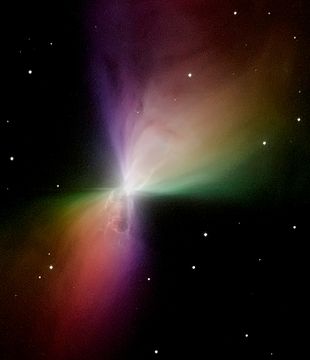Bumerangnebel
| Planetarischer Nebel Bumerangnebel | |
|---|---|
 | |
| Bumerangnebel, aufgenommen vom Hubble-Weltraumteleskop mit Polarisationsfilter. | |
| AladinLite | |
| Sternbild | Zentaur |
| Position Äquinoktium: J2000.0 | |
| Rektaszension | 12h 44m 45,45s [1] |
| Deklination | −54° 31′ 11,4″[1] |
| Erscheinungsbild | |
| Winkelausdehnung | 1,45′ × 0,72′ [1] |
| Zentralstern | |
| Physikalische Daten | |
| Entfernung | 5.000 Lj |
| Geschichte | |
| Entdeckung | Keith Taylor, Mike Scarrott |
| Datum der Entdeckung | 1980 |
| Katalogbezeichnungen | |
| ESO 172-7 • | |
Der Bumerangnebel (englisch Boomerang Nebula) ist ein planetarischer Nebel.
Der Bumerangnebel befindet sich im Sternbild Zentaur, 5.000 Lichtjahre von der Erde entfernt. Der Nebel ist mit 1 Kelvin der kälteste Ort im Universum, der außerhalb eines Labors bekannt ist.[2] Der Bumerangnebel besteht aus den Gasströmen eines in seinem Kern befindlichen Sterns, der diese abstößt. Das Gas entfernt sich mit ca. 600.000 km/h von diesem Stern. Diese Expansion ist der Grund für die Kälte des Nebels.

Der Bumerangnebel wurde im Jahre 1998 vom Hubble-Weltraumteleskop detailliert fotografiert.
Keith Taylor und Mike Scarrott haben den Nebel im Jahre 1980 benannt, nachdem sie ihn mit einem großen Teleskop von Australien aus beobachtet hatten. Da sie damals nicht in der Lage waren, genaue Details des Nebels zu erkennen, vermuteten sie, dass der Nebel wie ein Bumerang aussieht. Daher stammt der Name.
Siehe auch
Einzelnachweise
- ↑ a b BOOMERANG NEBULA. simbad.u-strasbg.fr, abgerufen am 3. September 2011.
- ↑ Lars Lindberg Christensen, Robert Fosbury: Hubble: 15 Jahre auf Entdeckungsreise, Wiley-VCH Verlag, 2006, ISBN 978-3-527-40682-1, Seite eingeschränkte Vorschau in der Google-Buchsuche
Weblinks
Auf dieser Seite verwendete Medien
Autor/Urheber:
Credit:
ALMA (ESO/NAOJ/NRAO)/R. Sahai, Lizenz: CC BY 4.0True shape of the Boomerang
This Picture of Week shows the Boomerang Nebula, a protoplanetary nebula, as seen by the Atacama Large Millimeter/submillimeter Array (ALMA). The background purple structure, as seen in visible light with the NASA/ESA Hubble Space Telescope, shows a classic double-lobe shape with a very narrow central region. ALMA’s ability to see the cold molecular gas reveals the nebula’s more elongated shape, in orange.
Since 2003 the nebula, located about 5000 light-years from Earth, has held the record for the coldest known object in the Universe. The nebula is thought to have formed from the envelope of a star in its later stages of life which engulfed a smaller, binary companion. It is possible that this is the cause of the ultra-cold outflows, which are illuminated by the light of the central, dying star.
ALMA looked at the nebula’s central dusty disc and the outflows further out, which span a distance of almost four light-years across the sky. These outflows are even colder than the cosmic microwave background, reaching temperatures below –270 °C. The outflows are also expanding at a speed of 590 000 kilometres per hour.
Link
NRAO press release
Credit:
ALMA (ESO/NAOJ/NRAO)/R. Sahai
Coordinates Position (RA): 12 44 46.10 Position (Dec): -54° 31' 12.87" Field of view: 0.37 x 0.37 arcminutes Orientation: North is 0.1° left of vertica
Colours & filters Band Wavelength Telescope Optical V 606 nm Hubble Space Telescope ACS Radio 12CO 880 μm Atacama Large Millimeter/submillimeter Array Band 7 Optical V 606 nm Hubble Space Telescope ACS.
Image of Boomerang nebula taken by Hubble Space Telescope

